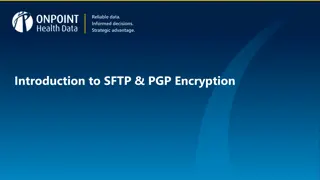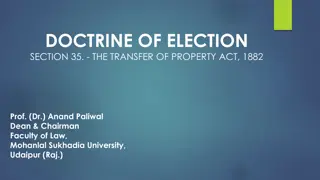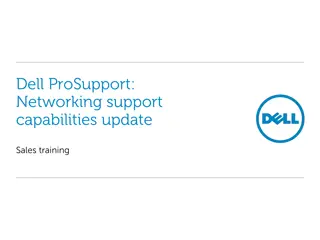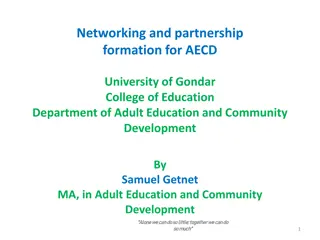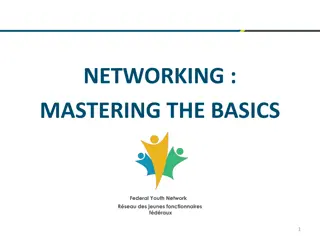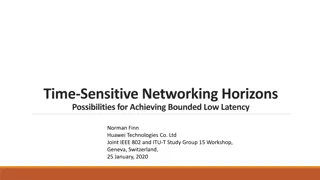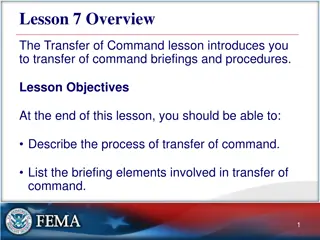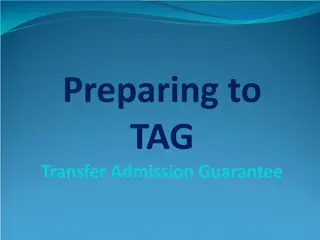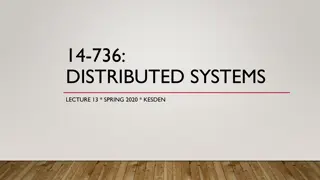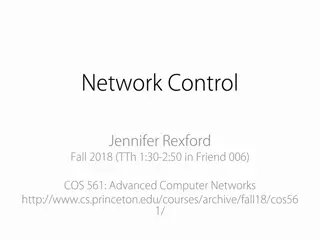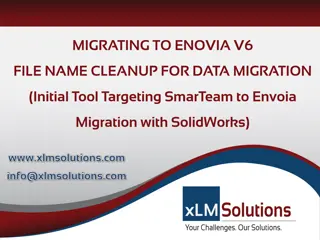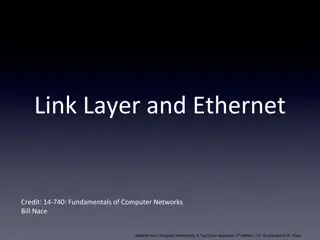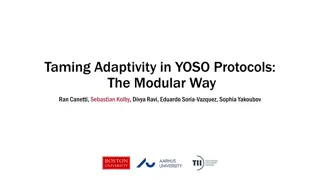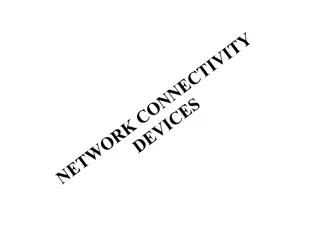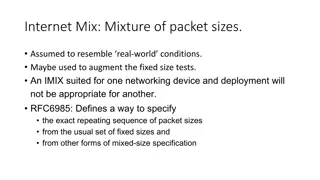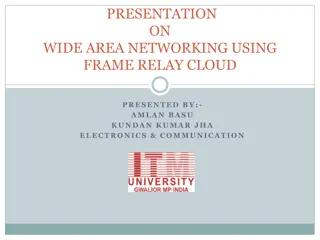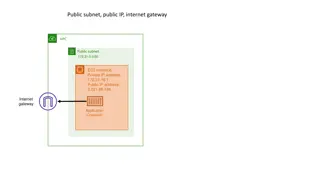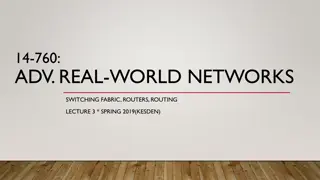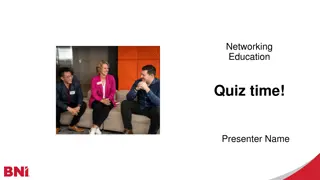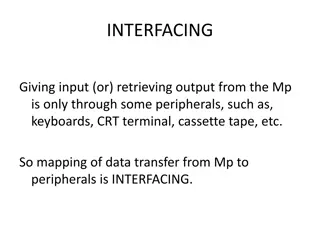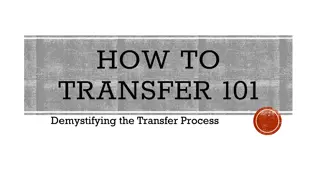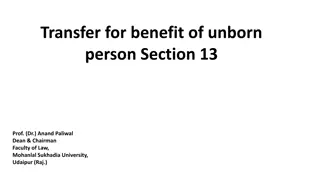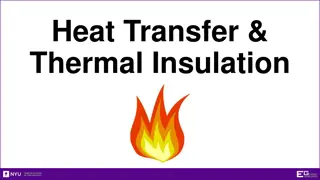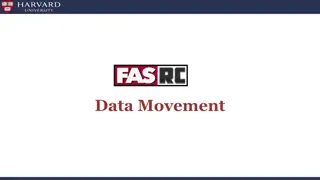Understanding File Transfer Protocols in Networking
Explore the fundamental concepts of File Transfer Protocol (FTP) in networking, covering its architecture, operation, commands, security considerations, and a comparison with Secure File Transfer Protocol (SFTP). Gain insights into how FTP enables the transfer of files between client and server, including the use of separate control and data connections. Learn about common FTP commands, responses, and the importance of transitioning to SFTP for enhanced security.
Download Presentation

Please find below an Image/Link to download the presentation.
The content on the website is provided AS IS for your information and personal use only. It may not be sold, licensed, or shared on other websites without obtaining consent from the author. Download presentation by click this link. If you encounter any issues during the download, it is possible that the publisher has removed the file from their server.
E N D
Presentation Transcript
Chapter 2: outline 2.1 principles of network applications app architectures app requirements 2.2 Web and HTTP 2.3 FTP 2.4 electronic mail SMTP, POP3, IMAP 2.5 DNS 2.6 P2P applications 2.7 socket programming with UDP and TCP Application Layer 2-1
FTP: the file transfer protocol file transfer FTP user interface FTP client FTP server user at host remote file system local file system transfer file to/from remote host client/server model client: side that initiates transfer (either to/from remote) server: remote host ftp: RFC 959 ftp server: port 21 Application Layer 2-2
FTP: separate control, data connections TCP control connection, server port 21 FTP client contacts FTP server at port 21, using TCP client authorized over control connection client browses remote directory, sends commands over control connection when server receives file transfer command, server opens 2ndTCP data connection (for file) to client after transferring one file, server closes data connection TCP data connection, server port 20 FTP client FTP server server opens another TCP data connection to transfer another file control connection: out of band FTP server maintains state : current directory, earlier authentication Application Layer 2-3
FTP commands, responses sample commands: sent as ASCII text over control channel USER username PASS password LISTreturn list of file in current directory RETR filenameretrieves (gets) file STOR filenamestores (puts) file onto remote host sample return codes status code and phrase (as in HTTP) 331 Username OK, password required 125 data connection already open; transfer starting 425 Can t open data connection 452 Error writing file Application Layer 2-4
FTP, SFTP FTP is not secure nothing is encrypted! SFTP uses SSH, and should be used instead of FTP when possible. 2: Application Layer 5
Chapter 2: outline 2.1 principles of network applications app architectures app requirements 2.2 Web and HTTP 2.3 FTP 2.4 electronic mail SMTP, POP3, IMAP 2.5 DNS 2.6 P2P applications 2.7 socket programming with UDP and TCP Application Layer 2-6
Electronic mail outgoing message queue user mailbox Three major components: user agents mail servers simple mail transfer protocol: SMTP user agent mail server user agent SMTP user agent mail server User Agent a.k.a. mail reader composing, editing, reading mail messages e.g., Outlook, Thunderbird, iPhone mail client outgoing, incoming messages stored on server SMTP SMTP user agent mail server user agent user agent Application Layer 2-7
Electronic mail: mail servers mail servers: mailbox contains incoming messages for user message queue of outgoing (to be sent) mail messages SMTP protocol between mail servers to send email messages client: sending mail server server : receiving mail server user agent mail server user agent SMTP user agent mail server SMTP SMTP user agent mail server user agent user agent Application Layer 2-8
Electronic Mail: SMTP [RFC 2821] uses TCP to reliably transfer email message from client to server, port 25 direct transfer: sending server to receiving server three phases of transfer handshaking (greeting) transfer of messages closure command/response interaction (like HTTP, FTP) commands: ASCII text response: status code and phrase messages must be in 7-bit ASCI Application Layer 2-9
Scenario: Alice sends message to Bob 1) Alice uses UA to compose message to bob@someschool.edu 2) Alice s UA sends message to her mail server; message placed in message queue 3) client side of SMTP opens TCP connection with Bob s mail server 4) SMTP client sends Alice s message over the TCP connection 5) Bob s mail server places the message in Bob s mailbox 6) Bob invokes his user agent to read message user agent user agent mail server 1 mail server 3 2 6 4 5 Alice s mail server Bob s mail server Application Layer 2-10
Sample SMTP interaction >telnet hamburger.edu 25 S: 220 hamburger.edu C: HELO crepes.fr S: 250 Hello crepes.fr, pleased to meet you C: MAIL FROM: <alice@crepes.fr> S: 250 alice@crepes.fr... Sender ok C: RCPT TO: <bob@hamburger.edu> S: 250 bob@hamburger.edu ... Recipient ok C: DATA S: 354 Enter mail, end with "." on a line by itself C: Do you like ketchup? C: How about pickles? C: . S: 250 Message accepted for delivery C: QUIT S: 221 hamburger.edu closing connection Handshake 2: Application Layer 11
Try SMTP interaction for yourself: telnet servername 25 see 220 reply from server enter HELO, MAIL FROM, RCPT TO, DATA, QUIT commands above lets you send email without using email client (reader) If you can send me an email . INCENTIVE!!!!!!!! Application Layer 2-13
SMTP: final words comparison with HTTP: SMTP uses persistent connections SMTP requires message (header & body) to be in 7-bit ASCII SMTP server uses CRLF.CRLF to determine end of message HTTP: pull SMTP: push both have ASCII command/response interaction, status codes HTTP: each object encapsulated in its own response msg SMTP: multiple objects sent in multipart msg Application Layer 2-14
Message format: multimedia extensions MIME: Multipurpose Internet Mail Extension, RFC 2045, 2056 additional lines in msg header declare MIME content type From: alice@crepes.fr To: bob@hamburger.edu Subject: Picture of yummy crepe. MIME-Version: 1.0 Content-Transfer-Encoding: base64 Content-Type: image/jpeg MIME version method used to encode data multimedia data type, subtype, parameter declaration base64 encoded data ..... ......................... ......base64 encoded data encoded data 2: Application Layer 15
MIME types Content-Type: type/subtype; parameters Text example subtypes: plain, html Video example subtypes: mpeg, quicktime Image example subtypes: jpeg, gif Application other data that must be processed by reader before viewable example subtypes: msword, octet-stream Audio example subtypes: basic (8- bit mu-law encoded), 32kadpcm (32 kbps coding) 2: Application Layer 16
Multipart Type From: alice@crepes.fr To: bob@hamburger.edu Subject: Picture of yummy crepe. MIME-Version: 1.0 Content-Type: multipart/mixed; boundary=StartOfNextPart --StartOfNextPart Dear Bob, Please find a picture of a crepe. --StartOfNextPart Content-Transfer-Encoding: base64 Content-Type: image/jpeg base64 encoded data ..... ......................... ......base64 encoded data --StartOfNextPart Do you want the recipe? 2: Application Layer 17
Mail access protocols mail access protocol (e.g., POP, IMAP) user agent user agent SMTP SMTP sender s mail server receiver s mail server SMTP: delivery/storage to receiver s server mail access protocol: retrieval from server POP: Post Office Protocol [RFC 1939]: authorization, download IMAP: Internet Mail Access Protocol [RFC 1730]: more features, including manipulation of stored msgs on server HTTP: gmail, Hotmail, Yahoo! Mail, etc. Application Layer 2-19
POP3 protocol S: +OK POP3 server ready C: user bob S: +OK C: pass hungry S: +OK user successfully logged on authorization phase client commands: user: declare username pass: password server responses +OK -ERR transaction phase, client: list: list message numbers retr: retrieve message by number dele: delete quit C: list S: 1 498 S: 2 912 S: . C: retr 1 S: <message 1 contents> S: . C: dele 1 C: retr 2 S: <message 1 contents> S: . C: dele 2 C: quit S: +OK POP3 server signing off Application Layer 2-20
POP3 (more) and IMAP more about POP3 previous example uses POP3 download and delete mode Bob cannot re-read e- mail if he changes client POP3 download-and- keep : copies of messages on different clients POP3 is stateless across sessions IMAP keeps all messages in one place: at server allows user to organize messages in folders keeps user state across sessions: names of folders and mappings between message IDs and folder name Application Layer 2-21
Chapter 2: outline 2.1 principles of network applications app architectures app requirements 2.2 Web and HTTP 2.3 FTP 2.4 electronic mail SMTP, POP3, IMAP 2.5 DNS 2.6 P2P applications 2.7 socket programming with UDP and TCP Application Layer 2-22
DNS: domain name system people: many identifiers: SSN, name, passport # Internet hosts, routers: IP address (32 bit) - used for addressing datagrams name , e.g., www.yahoo.com - used by humans Q: how to map between IP address and name, and vice versa ? Domain Name System: distributed database implemented in hierarchy of many name servers application-layer protocol: hosts, name servers communicate to resolve names (address/name translation) note: core Internet function, implemented as application- layer protocol complexity at network s edge Application Layer 2-23
DNS: services, structure why not centralize DNS? single point of failure traffic volume distant centralized database maintenance A: doesn t scale! DNS services hostname to IP address translation host aliasing canonical, alias names mail server aliasing load distribution replicated Web servers: many IP addresses correspond to one name Application Layer 2-24
DNS: a distributed, hierarchical database Root DNS Servers org DNS servers edu DNS servers com DNS servers poly.edu DNS servers umass.edu DNS servers pbs.org DNS servers yahoo.com DNS servers amazon.com DNS servers client wants IP for www.amazon.com; 1st approx: client queries root server to find com DNS server client queries .com DNS server to get amazon.com DNS server client queries amazon.com DNS server to get IP address for www.amazon.com Application Layer 2-25
DNS: root name servers contacted by local name server that can not resolve name root name server: contacts authoritative name server if name mapping not known gets mapping returns mapping to local name server c. Cogent, Herndon, VA (5 other sites) d. U Maryland College Park, MD h. ARL Aberdeen, MD j. Verisign, Dulles VA (69 other sites ) k. RIPE London (17 other sites) i. Netnod, Stockholm (37 other sites) m. WIDE Tokyo (5 other sites) e. NASA Mt View, CA f. Internet Software C. Palo Alto, CA (and 48 other sites) 13 root name servers worldwide a. Verisign, Los Angeles CA (5 other sites) b. USC-ISI Marina del Rey, CA l. ICANN Los Angeles, CA (41 other sites) g. US DoD Columbus, OH (5 other sites) Application Layer 2-26
TLD, authoritative servers top-level domain (TLD) servers: responsible for com, org, net, edu, aero, jobs, museums, and all top-level country domains, e.g.: uk, fr, ca, jp Network Solutions maintains servers for .com TLD Educause for .edu TLD authoritative DNS servers: organization s own DNS server(s), providing authoritative hostname to IP mappings for organization s named hosts can be maintained by organization or service provider Application Layer 2-27
Local DNS name server does not strictly belong to hierarchy each ISP (residential ISP, company, university) has one also called default name server when host makes DNS query, query is sent to its local DNS server has local cache of recent name-to-address translation pairs (but may be out of date!) acts as proxy, forwards query into hierarchy Application Layer 2-28
DNS name resolution example root DNS server 2 3 host at cis.poly.edu wants IP address for gaia.cs.umass.edu TLD DNS server 4 5 local DNS server dns.poly.edu iterated query: contacted server replies with name of server to contact I don t know this name, but ask this server 6 7 1 8 authoritative DNS server dns.cs.umass.edu requesting host cis.poly.edu gaia.cs.umass.edu Application Layer 2-29
DNS name resolution example root DNS server 3 2 recursive query: puts burden of name resolution on contacted name server heavy load at upper levels of hierarchy? 7 6 TLD DNS server local DNS server dns.poly.edu 4 5 1 8 authoritative DNS server dns.cs.umass.edu requesting host cis.poly.edu gaia.cs.umass.edu Application Layer 2-30
DNS: caching, updating records once (any) name server learns mapping, it caches mapping cache entries timeout (disappear) after some time (TTL) TLD servers typically cached in local name servers thus root name servers not often visited cached entries may be out-of-date (best effort name-to-address translation!) if name host changes IP address, may not be known Internet-wide until all TTLs expire update/notify mechanisms proposed IETF standard RFC 2136 Application Layer 2-31
DNS records DNS: distributed db storing resource records (RR) RR format:(name, value, type, ttl) type=A nameis hostname valueis IP address type=CNAME name is alias name for some canonical (the real) name www.ibm.comis really servereast.backup2.ibm.com valueis canonical name type=NS name is domain (e.g., foo.com) value is hostname of authoritative name server for this domain type=MX valueis name of mailserver associated withname Application Layer 2-32
DNS protocol, messages query and reply messages, both with same message format 2 bytes 2 bytes msg header identification: 16 bit # for query, reply to query uses same # flags: query or reply recursion desired recursion available reply is authoritative identification flags # questions # answer RRs # additional RRs # authority RRs questions (variable # of questions) answers (variable # of RRs) authority (variable # of RRs) additional info (variable # of RRs) Application Layer 2-33
DNS protocol, messages 2 bytes 2 bytes identification flags # questions # answer RRs # additional RRs # authority RRs name, type fields for a query questions (variable # of questions) RRs in response to query records for authoritative servers answers (variable # of RRs) authority (variable # of RRs) additional helpful info that may be used additional info (variable # of RRs) Application Layer 2-34
Inserting records into DNS example: new startup Network Utopia register name networkuptopia.com at DNS registrar (e.g., Network Solutions errr) provide names, IP addresses of authoritative name server (primary and secondary) registrar inserts two RRs into .com TLD server: (networkutopia.com, dns1.networkutopia.com, NS) (dns1.networkutopia.com, 212.212.212.1, A) create authoritative server type A record for www.networkuptopia.com; type MX record for networkutopia.com Application Layer 2-35



